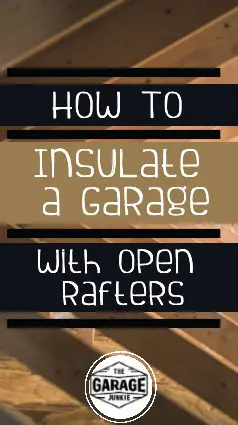Quick and Easy Steps for Insulating your Open Rafter Garage
Most of us don’t spend much time considering our garage’s insulation capabilities, but we should, because if your garage’s roof isn’t insulated, it could be costing you a fortune. And the problem is more widespread than you might think. In fact, walk in to almost any single-story garage in America, look up, and you are bound to see a typical, inefficient, open rafter roof. And it should come as no surprise that the for reasons for this are something besides everyone happening to love the look of exposed beams over their garage parking car pad.
Open rafter garages are popular not only because they are inexpensive to construct, but the resulting roofs are surprisingly strong and sturdy as well. This is also great for those looking to better utilize their garage’s space and who want to make it as welcoming and efficient of an area as possible. One simple way to do this involves insulating your garage’s open rafters to avoid inefficiencies that can often be attributed to attic heat loss. This is relatively simple roof insulation work that can be easily adapted for almost any situation. Starting is as easy as finding out what type of garage ceiling insulation would be right for you. Next, we will take a look at some recommended products and helpful steps to take when insulating your own garage with open rafters.

So, if you have been wondering how to insulate your garage, or how to insulate a garage with open rafters in particular, have no fear, you’ve come to the right place. We here at The Garage Junkie are experts at maximizing whatever garage space you have to work with. And, by using the tips and tricks outlined in our guide below, we hope to prove the installation of your open rafter insulation can be a snap.
Do You Have an Open Rafter Garage?
The first step that anyone undertaking a garage insulation project should do is to find out what type of garage they have. This is important because determining what construction style you have will greatly inform how much weight your garage’s roof can support and thus what type of insulation you should use.
A garage can normally be differentiated by its ceiling support structure, which can be broken into three categories. The first two are defined by their joist or floor truss constructions respectively. The last type is the open-ceiling trusses and rafters’ style, which will be the focus of this guide. Your garage’s own structure can normally be easily determined with some simple detective work thanks to a garage’s unfinished nature.
Rafters vs. Trusses: What’s the Difference?
From the outside, a typical trusses and rafters style garage is identifiable from the outside by its single-story height and pitched roof. On the inside, rafters and trusses can be easily differentiated by their appearance. Both styles will appear similar at first, this is thanks to common attributes they both have, such as sections that span the entirety of most garages, bottom joists and rafter boards. The most readily identifiable difference you can usually spot is that trusses will have been prefabricated off-site to the exact dimensions of your garage. Thus, trusses typically use more 2x4s in their structure than you would find in normal rafter constructions, which lends them a more distinctive webbing design.
Long story short – the only real difference that you should be concerned about when it comes to the utility of rafters versus trusses and this project is how it will affect the amount of weight your existing structure will be able to support. In general, trusses will be able to support more weight and will be more cost effective to work with. But if your structure is already built, you don’t have much choice at this point, do you?
What Open Rafter Insulation is Right for My Garage?
Now that you have determined that you have the correct open rafter style garage for this guide, the next step is figuring out what insulation is right for your particular garage’s situation.
The following factors can be useful to consider when determining how to insulate your open rafter garage:
- Is your garage attached to your home, or another structure? Or is it a separate stand-alone garage? This will factor in greatly to how insulated your garage needs to be and what possible solutions you can employ.
- Is your garage heated? And if so, how? This will affect if you need to look into installing ventilation or additional sheathing when installing your insulation.
- How tall is your garage’s attic space? The volume of the space you are trying to insulate will greatly impact the choices you have in terms of what insulation you should consider using.
- Besides the ceiling and roof area, how is the rest of your garage insulated? The key to proper garage insulation is considering what will be most effective for the entire space when designing solutions.
- What are typical weather conditions for your area?
- How is your garage’s roof designed to deal with them? Focus most intensely on seasonal extremes, such as how your roof handles high and low temperatures or possible snow and ice weight management.
With the above in mind, you can read on below to begin to consider what insulation options will be right for your own garage space.
Typical Insulation Options for Open Raftered Garages
Options for insulating your open rafter or truss garage can include many professional and DIY solutions. The only real limit is your imagination and budget. For most homeowners, however, insulating their garage (or any exposed rafter area) will take the form of one of the following solutions.
A Finished Ceiling
The first option many are tempted to go with is to finish the ceiling of their garage. Aside from the potential load issues, that is if your garage can’t support the weight of a ceiling, this is a fine solution for many. A finished ceiling is most often accomplished by installing drywall or a tongue and groove system to the underside of your garage’s joists. Insulation is then installed on the exterior facing side of this ceiling. For obvious reasons, this solution is not recommended for those whose garages have particularly high (or cathedral) ceilings.
Minimal Insulation
If you live in an area where the climate requires minimal insulation, an insulation approach such as the use of rigid foam, or a thin layer of aluminum, may be more than adequate for your needs. This solution might not work for every situation, however, as it is most often installed between a ceiling and a sheathing.
Structural Insulated Panels
Structural insulated panels (SIPs) have exploded in popularity recently as an affordable and easy way to insulate exposed rafter constructions. Each SIP is a prefabricated unit that is comprised of layers of foam insulation and conventional boards. SIPs are most often used in timber-frame constructions because they can provide both sheathing and insulation. The SIPs are simply installed on the interior of your roofing material between your trusses or rafters. This is a great option for those that don’t have finished ceilings already, as they can be fitted with drywall or finished board faces to make them more presentable.
Helpful Steps When Installing Open Rafter Insulation
While the installation process will look different based on your situation and chosen insulation solution, there are still some helpful tips and tricks that anyone can use when undergoing an open rafter insulation project.
- When installing insulation, be sure to keep in mind the importance of ventilation in any space like a garage. Being able to vent the fumes from a car’s exhaust alone is important.
- Invest in a quality painter’s ladder, like this one, as you will be spending a lot of time off of the ground.
- Sheathing will be an important part of whatever insulation solution you choose, but it will be most important for those in colder or humid climates, as proper use will help regulate moisture levels.
- Consider buying a painter platform, like this one, if you will be doing intensive tasks at attic height such as installing a finished ceiling.
Final Thoughts: The Case for an Entire Garage Insulation Solution
Now that we’ve guided you through how to insulate a garage with open rafters, it’s time for our final thoughts on garage insulation and why insulating the roof should just be your garage’s beginning. If you insulate your garage’s ceiling but fail to undertake similar precautions with the rest of your space, you won’t really have accomplished much at all. This is because for insulation to be effective, it has to address every surface and possible source of draft.
For example, insulating your garage’s roof will have little impact if you fail to adequately address other areas that need insulation such as ventilation ports or drafty windows. One such part of a garage that is often overlooked is the garage door itself. By combining your roof insulation with additional solutions for the rest of your space, like insulating your garage door with this kit, you’ll ensure optimal insulation for your garage. Check out our articles about the benefits of garage door insulation and how to DIY your own.
Thus conclude our guide to insulating your open rafter garage ceiling. We hope that you have enjoyed reading and learned something new along the way. Be sure to keep it tuned to The Garage Junkie for even more great garage DIY and FYI.
